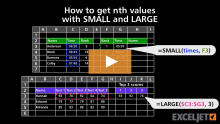Maximum value
In this example, the goal is to get the maximum quiz score (i.e. the best quiz score) for each person listed in column B from the five quiz scores that appear in columns C through G. This is a job for the MAX function or the LARGE function, as explained below.
MAX function
The...Read more

